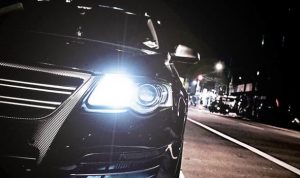You must always use your headlights when driving on the motorway at night unless forced to stop on the hard shoulder. You are only allowed to use the hard shoulder if you break down or notice a fault with your car. If you do have to stop on the hard shoulder, then you should switch your headlights off. However, you should leave your sidelights and hazard warning lights on if possible. This will help to ensure that other road users can still see your vehicle.
What should you do when broken down at the side of the motorway?
If you breakdown on the motorway, as well as turning off your headlights and turning on your hazard lights and sidelights, you should:
 Safely come to a stop on the hard shoulder if possible
Safely come to a stop on the hard shoulder if possible- Position your wheels away from the carriageway
- Wear reflective clothing if possible
- Leave the vehicle via the passenger side (including all passengers)
- Call your breakdown provider, either with your mobile or by walking to the nearest emergency phone
- Pick up speed on the hard shoulder before rejoining the main carriageway if repairs have been made by your breakdown provider
You should not:
- Try and fix your car yourself
- Take animals out of the car with you
- Put a warning triangle on the hard shoulder
Theory Test Question
So, how did you answer the theory test question: You’re driving on a motorway at night. When may you switch off your headlights? Let’s consider each of the answers in extra detail:
When your vehicle is broken down on the hard shoulder
Correct! The only time you should turn off your headlights on a motorway at night is when you have broken down on the hard shoulder. Be sure to leave your sidelights on though and switch on the hazard warning lights too.
When the motorway is lit
Wrong! It is best practice to use dipped headlights when driving at night time even if the motorway or road is lit.
When you’re travelling below 50 mph
Wrong! Your headlights make you more visible to others and this is not affected by your speed.
When there are vehicles close in front of you
Wrong! Dipped headlights do not dazzle the car in front, instead, they make you visible to them, making them aware of you being behind them.
References
In section 15 of the official DVSA guide to driving, it states:
If you do break down on the motorway, try and reach the next exit or service area. If you can’t do this, steer your vehicle onto the hard shoulder as safely as possible, and as far to the left as you can, away from traffic.
When you stop, it’s a good idea to have your wheels turned to the left so that, if you’re hit from behind, your vehicle isn’t pushed onto the main carriageway.
When you stop
Once you’ve stopped
- switch on your hazard lights to warn other drivers that you’ve broken down
- make sure your sidelights are on in poor visibility or at night
- don’t open the offside doors
- warn your passengers of the dangers of passing vehicles
- keep animals inside
- with your passengers, leave the vehicle by the nearside door away from the traffic. Lock all doors, except the front passenger door
- ask your passengers to wait near the vehicle, but on the embankment away from the hard shoulder
- telephone the emergency services. (Let them know if you’re a vulnerable motorist such as a disabled or older person, or are travelling alone or with young children.) If possible, use a roadside emergency telephone, which will pinpoint your position, rather than a mobile phone.



